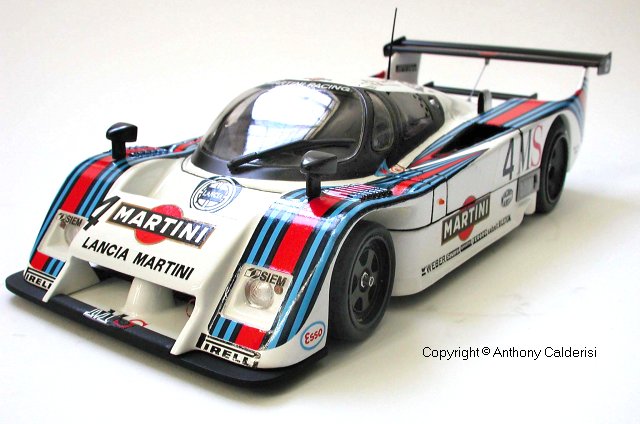
1/24 Lancia LC2 and Integrale
Model, Text and Photos by Anthony Calderisi

A Martini racing calendar was the inspiration to have the Lancia LC2 in my protoype collection. And even though the kit was an old curbside from Protar, I knew of a local store who had a dozen or so sitting on their shelves.
I'm happy I went through the trouble of building this kit, because I'm quite pleased with the final result. The colour scheme is striking and the shape of the car is unique. However, getting the model to look right required an investment in time that could have been spent fully wiring and plumbing a beautiful power plant on another car. This kit is a real dog. The metal body (the kit can also be found with a plastic body) had to be filed down in places so that the different body panels would line up (the doors open).
There isn't much detail or precision as compared to a Tamiya kit. Whatever detail there is is either unsharp, vague or incorrect. Once the body was filed, filled, sanded, and the doors fit, I went ahead with some corrections. The metal body was too thick for scale in obvious places, vents etc. and I thinned out these places to help capture a scale feeling.
All clear plastic parts in the kit were smoked, which was incorrect as regards the clear headlight covers. The turn light signal was missing and the headlight was represented as a blob of plastic molded into the headlight cover. Gross! I made my own clear headlight covers, turn signals, and headlights, as well as a different SIEM decal with the company logo.
The rear axle was relocated 1or 2mm forward to center the wheels in the wheel well. A side marker light was made out of clear plastic and the windshield wiper was bent to fit the curve of the windshield. I added extensions to the front air inlet and removed a part that I found unnecessary.
A few box photos as well as my calendar provided a few clues as to detailing. Rear wing adjusters were added, a rear taillight with a clear lens, tow hooks front and rear, drilled out exhaust pipes, SPEEDLINE decals on the wheels, and a PERSONAL decal on the steering wheel. The rear wing sides were the scale thickness of a brick and were sanded down to something this side of aerodynamic.
The side windows were horribly thick due to their 'snap in' concept. They were sanded down to a believable scale thickness, ventilated with five holes and retinted with clear smoke. The incorrect and no longer required window sill was removed, yielding a much more accurate side window representation.
Finally after the body was painted, it was time to lay down those deliciously colour-saturated decals by Cartograph. Another challenge. The decals were thick and wouldn't conform to body curves.
The vents on the front fender? Impossible. I made my own decals and touched up with paint. Also it seemed as if there was not enough glue on the decal, and this prevented the decals from staying down. I had to apply glue from donor decals to get them to stick.
I consider every model I make a learning experience that helps me make the next one that much better. This one was a college education.
While on vacation in the South of France, I came across this Lancia Delta Integrale sporting Martini colours.
This would probably have been a special edition road going Delta after having won the WRC, similar to the Subaru WRX today. (WRC fans correct me if I'm wrong please.) I loved it so much I wanted to make it the subject of a scale model. A friend found me a curbside kit in France and sent it over as a gift.
The kit was built straight out of the box, the only changes being the replacement of the front grille and the small grilles at the front fender bulges with real screen. The front face was chromed, the exhaust tips drilled out, an antenna added, windows tinted blue and SABELT seat belts added to the interior.
The Martini stripes and decals were the challenge. I glued tracing paper to the body and traced the shape which was then scanned into the computer. I produced the artwork based on the shape of my scanned tracing and my photo references in a Vector based drawing program, but I discovered that my output was actually better coming from a pixel based program, with no jaggies. All decals are accurate and to scale, even the license plates are authentic with the Monte Carlo crest.
This project introduced me to working with my own decals using computer generated art and blank decal sheet and paper output. The stripes along the sides are actually printed on paper! Precision cut, glued on with dryline double sided glue, then clear coated. The other decals are printed on blank decal sheet. I have since changed brand of blank decal sheet with far better results.














